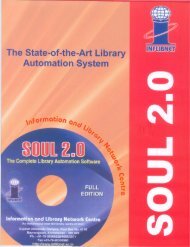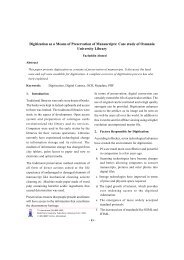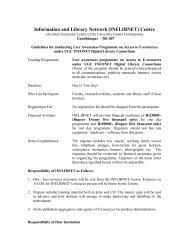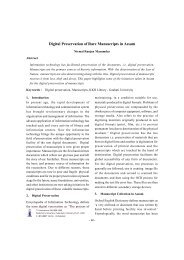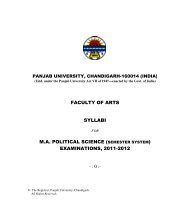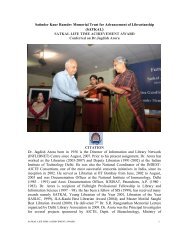Vol.18- No.1 (Jan-Mar2011) - INFLIBNET Centre
Vol.18- No.1 (Jan-Mar2011) - INFLIBNET Centre
Vol.18- No.1 (Jan-Mar2011) - INFLIBNET Centre
You also want an ePaper? Increase the reach of your titles
YUMPU automatically turns print PDFs into web optimized ePapers that Google loves.
Feature Article : Cloud Computing and Its Impacton Library ServicesCloud computing is a buzz word now a days in the worldof ICT. The concept has made huge impact in thetechnological application especially pertaining to thedatabase and software applications. The cloud computingcan be effectively implemented in various libraryapplication too. Different services and applications beingused in library for providing services to the users areinfluenced with cloud computing. Shri Yatrik Patel,Scientist C (CS) of the <strong>Centre</strong> touches upon the topic ofcloud computing in his article entitled “Cloud computingand its impact on library services”protocols to balance the computational load acrossthe machines. As a user, one need not care aboutwhich CPU ran the program, and the clustermanagement software ensured that the “best” CPUat that time was used to run the code.In the early 1990s, Ian Foster and Carl Kesselmancame up with a new concept called “Grid”. Withanalogy to the electricity grid where users could pluginto the grid and use a metered utility service. Thesame was applied for computing resources in caseof grid computing where in a user plug into a grid ofcomputers and pay for what he/she uses. Gridcomputing expands the techniques of clustering“Cloud Computing” sounds like a new term, actually it is not,infact the term “Cloud” evolved with history of Internet itself.where multiple independent clusters act like a grid due to theirnature of not being located in a single domain.The idea of an “intergalactic computer network” was introducedin the sixties by J.C.R. Licklider (aka “Lick”) , who was responsiblefor enabling the development of ARPANET (Advanced ResearchProjects Agency Network) in 1969.The main bottleneck for moving cluster computing to gridcomputing was “data residency”. The computers in the clusterwere usually physically connected to the disks holding the data,where as in grid the computational nodes could be situatedAccording to Larry Roberts, the primary ARPANET architect“Lick had this concept of the intergalactic network which hebelieved was everybody could use computers anywhere andget at data anywhere in the world… He didn’t have a clue howanywhere in the world. It was fine having all that CPU poweravailable, but the data on which the CPU performed its operationscould be thousands of miles away, causing a delay (latency)between data fetched and its execution.to build it. He didn’t have any idea how to make this happen.But he knew it was important, so he sat down with me andreally convinced me that it was important and convinced meinto making it happen.”To avoid this bottleneck and to take grid further at the level ofservice, concept of the cloud computing was introduced, assuch concepts of grid computing was evolved to a service offeredby data centres.Other experts attribute the concept of cloud computing tocomputer scientist John McCarthy who proposed the idea ofcomputation being delivered as a public utility which date backIn short the concept of “cloud” does not only involve computersbut also encompassesto the sixties.GGFirst cloud around networking (TCP/IP abstraction)Second cloud around documents (WWW data abstraction)In the past, computers were clustered together to form a singlelarger computer as common industrial practice that allowed usersto configure computers to talk with each other using standardG The currently emerging cloud abstracts infrastructurecomplexities of servers, applications, data, andheterogeneous platforms.Vol. 18, No. 1 (<strong>Jan</strong>uary to March 2011) 17


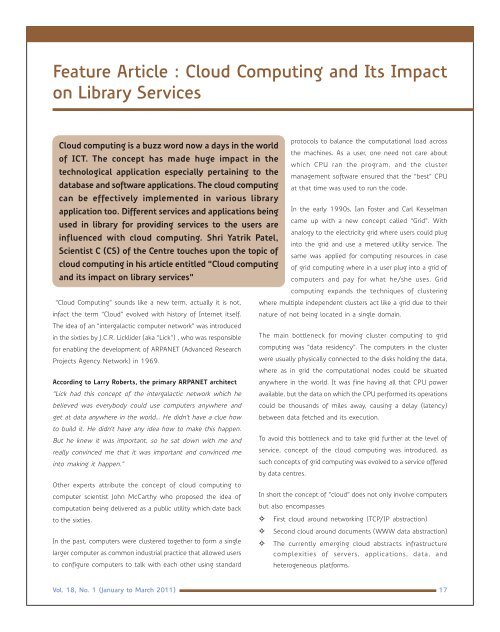
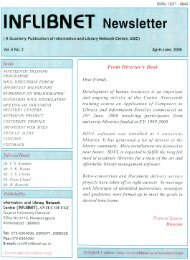

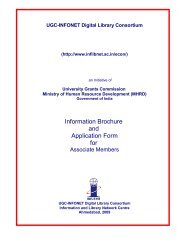
![Uni of Delhi_MA_History[1]. - INFLIBNET Centre](https://img.yumpu.com/48586372/1/190x245/uni-of-delhi-ma-history1-inflibnet-centre.jpg?quality=85)
